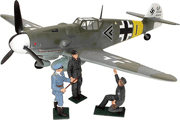Die Casting Manufacturing Review
Die Casting Manufacturing Review
Die casting process uses a split metal tool die where molten metal is injected at high pressure. The cast part is ejected from the tool die by ejector pins on one of the tool die halves. Die casting is best where high production, accuracy, smooth surfaces and intricate small parts are desired. Only non-ferrous materials are die cast, such as aluminum-, zinc-, magnesium, and copper-based alloys.
Manufacturing production rates of 20-200 pieces/hr-mold are typical. The maximum mass limits for magnesium, zinc, and aluminum parts are roughly 4.5 kg, 18 kg, and 45 kg, respectively; the lower limit in all cases is about 30 g. Die injection machines are generally large (up to 3 X 8 m) and operate at high pressures - 1000 kg/cm2 and higher, although aluminum usually is processed at lower pressure. Set-up or lead time for die tools ranges from 6 to 10 weeks, after which a properly designed die tool set can produce over 500,000 castings during the production lifetime.
This process is used for producing large volumes of zinc, aluminum and magnesium castings of intricate shapes. The essential feature of die casting is the use of permanent metal dies into which the molten metal is injected under high pressure (normally 5000 psi or more).
Advantages
Cost of castings is relatively low with high volumes.
High degree of design complexity and accuracy.
Excellent smooth surface finish.
Suitable for relatively low melting point metals (1600F/871C) like lead, zinc, aluminum, magnesium and some copper alloys.
High production rates.
Disadvantages
Limits on the size of castings - most suitable for small castings up to about 75 lb.
Equipment and die costs are high.
Die casting is a process commonly used in the mass production of non-ferrous metal parts. The most notable of products manufactured using the die casting process is match-box cars and other toys.
 |
 |